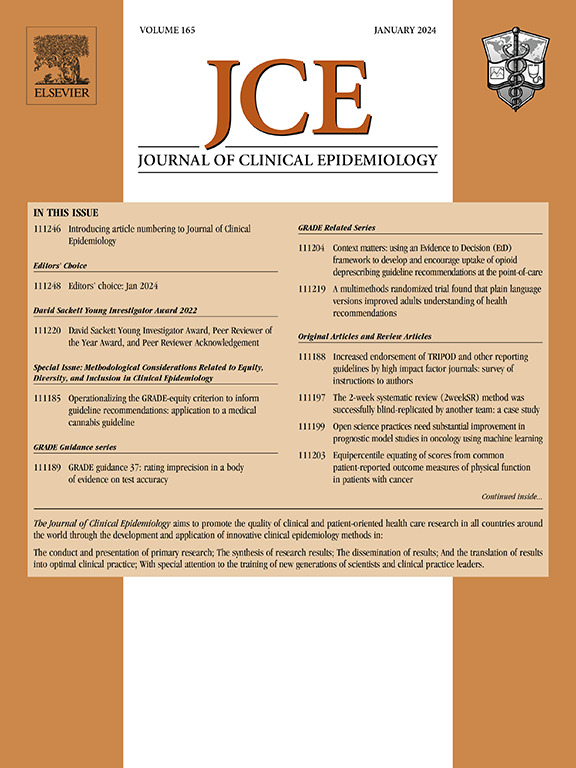The definition of predictor and outcome variables in mortality prediction models: a scoping review and quality of reporting study
IF 7.3
2区 医学
Q1 HEALTH CARE SCIENCES & SERVICES
引用次数: 0
Abstract
Background and Objectives
Mortality prediction models are promising tools for guiding clinical decision-making and resource allocation in intensive care units (ICUs). Clearly specified predictor and outcome variables are necessary to enable external validation and safe clinical application of prediction models. The objective of this study was to identify the predictor and outcome variables used in different mortality prediction models in the ICU and investigate their reporting.
Methods
For this scoping review, MEDLINE, EMBASE, Web of Science, and the Cochrane Central Register of Controlled Trials were searched. Studies developed within a general ICU population reporting on prediction models with mortality as a primary or secondary outcome were eligible. The selection criteria were adopted from a review by Keuning et al. Predictor and outcome variables, variable characteristics (defined as units, definitions, moments of measurement, and methods of measurement), and publication details (defined as first author, year of publication and title) were extracted from the included studies. Predictor and outcome variable categories were demographics, chronic disease, care logistics, acute diagnosis, clinical examination and physiological derangement, laboratory assessment, additional diagnostics, support and therapy, risk scores, and (mortality) outcomes.
Results
A total of 56 mortality prediction models, containing 204 unique predictor and outcome variables, were included. The predictor variables most frequently included in the models were age (40 times), admission type (27 times), and mechanical ventilation (21 times). We observed that single variables were measured with different units, according to different definitions, at a different moment, and with a different method of measurement in different studies. The reporting of the unit was mostly complete (98% overall, 95% in the laboratory assessment category), whereas the definition of the variable (74% overall, 63% in the chronic disease category) and method of measurement (70% overall, 34% in the demographics category) were most often lacking.
Conclusion
Accurate and transparent reporting of predictor and outcome variables is paramount to enhance reproducibility, model performance in different contexts, and validity. Since unclarity about the required input data may introduce bias and thereby affect model performance, this study advocates that prognostic ICU models can be improved by transparent and clear reporting of predictor and outcome variables and their characteristics.
"死亡率预测模型中预测变量和结果变量的定义:范围审查和报告质量研究"。
背景:死亡率预测模型是指导重症监护病房(ICU)临床决策和资源分配的有效工具。明确规定预测变量和结果变量对于预测模型的外部验证和安全临床应用是必要的。本研究旨在确定重症监护室不同死亡率预测模型中使用的预测变量和结果变量,并调查其报告情况:方法:本范围综述检索了 MEDLINE、EMBASE、Web of Science 和 Cochrane 对照试验中央注册中心 (CENTRAL)。以死亡率为主要或次要结果的预测模型为研究对象的研究均为在普通重症监护病房人群中开展的研究。从纳入的研究中提取了预测变量和结果变量、变量特征(定义为单位、定义、测量时刻和测量方法)以及发表的详细信息(定义为第一作者、发表年份和标题)。预测因子和结果变量类别包括人口统计学、慢性疾病、护理后勤、急性诊断、临床检查和生理失调、实验室评估、额外诊断、支持和治疗、风险评分和(死亡率)结果:结果:共纳入了 56 个死亡率预测模型,其中包含 204 个独特的预测变量和结果变量。最常被纳入模型的预测变量是年龄(40 次)、入院类型(27 次)和机械通气(21 次)。我们注意到,在不同的研究中,单一变量的测量单位不同、定义不同、时间不同、测量方法也不同。单位的报告大多是完整的(总体为98%,实验室评估类别为95%),而变量的定义(总体为74%,慢性病类别为63%)和测量方法(总体为70%,人口统计学类别为34%)则往往缺乏:结论:准确、透明地报告预测变量和结果变量对于提高可重复性、模型在不同情况下的表现和有效性至关重要。由于所需输入数据的不明确性可能会带来偏差,从而影响模型的性能,因此本研究提倡通过透明、清晰地报告预测变量和结果变量及其特征来改进 ICU 预后模型。
本文章由计算机程序翻译,如有差异,请以英文原文为准。
求助全文
约1分钟内获得全文
求助全文
来源期刊

Journal of Clinical Epidemiology
医学-公共卫生、环境卫生与职业卫生
CiteScore
12.00
自引率
6.90%
发文量
320
审稿时长
44 days
期刊介绍:
The Journal of Clinical Epidemiology strives to enhance the quality of clinical and patient-oriented healthcare research by advancing and applying innovative methods in conducting, presenting, synthesizing, disseminating, and translating research results into optimal clinical practice. Special emphasis is placed on training new generations of scientists and clinical practice leaders.
 求助内容:
求助内容: 应助结果提醒方式:
应助结果提醒方式:


